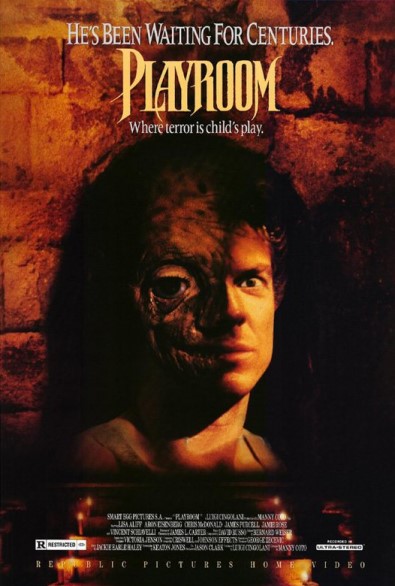Matty digs up a forgotten shocker from the co-producers of A Nightmare on Elm Street, the director of Dr. Giggles, and, erm, Jackie Earle Haley.
Long before Jackie Earle Haley inherited Freddy’s fedora for the dreary A Nightmare on Elm Street remake (2010), he submitted a script for a psychological horror flick called ‘Schizo’ to one of the original Elm Street’s co-producers, Smart Egg Pictures. At the time, the twenty-seven year-old former child star was having trouble transitioning into grown-up roles and reasoned that screenwriting would be a good career change. Alas, Haley’s brief dalliance with the typewriter was as professionally miserable as the (so-called) ‘slump’ that resulted in his casting in Dollman (1991), Nemesis (1992), and Maniac Cop 3: Badge of Silence (1993), just prior to a sabbatical that saw him abandon acting for well over a decade. Smart Egg bought the ‘Schizo’ script, dumped Haley — who, allegedly, was also angling to direct — and recruited another twenty-seven year-old megaphone-wielding debutant to shepherd what the company was now calling PLAYROOM (1990).
“I was literally three weeks out of the AFI film school when I got the deal to direct Playroom,” helmer Manny Coto told Gorezone in 1992. “It was a nightmare! It was no money, and a strange, strange deal. [Smart Egg] had this weird script and it was a ‘take it or leave it’ situation. But it was a beginning, even if it was hell to make!” [1]
Hell indeed.
Lensing Playroom for buttons on location in what was then Yugoslavia — the home turf of Smart Egg founder Djordje ‘George’ Zecevic — Coto and the small American contingent of his crew found themselves slap-bang in the middle of a country on the edge of civil war. Still, every cloud. As life-threatening as Yugoslavia’s social, economical, and political tensions were, they do lend the polished if dramatically inert Playroom a suitably menacing atmosphere; an attribute aided by Coto’s feel for tension-twisting detail (love those increasingly more frantic pickaxe whacks) and his eye for an arresting visual. With the bulk of Playroom unspooling in the ruins of a Slavic castle, Coto succeeds in presenting the place as a darkly alluring netherworld; a spooky amusement park that, in keeping with the film’s sadly half-baked themes of physical and personal excavation, the curious or those with a thirst for the macabre couldn’t help but explore.
Playroom’s narrative failings, though, are epitomised by Coto’s underuse of the eponymous torture chamber. Fashioned by production designer Vicky Jensen — the future co-director of animated favourites Shrek (2001) and Shark Tale (2004) — the candle-lit pain pit is an impressive bit of scenery. However, in a flub so indicative of Coto’s equally gimmicky subsequent features, Dr. Giggles (1992) and Star Kid (1997), that it’s tempting to rule it an auteurist flourish, the playroom is a cool concept but not much else. For a man who’d go on to be an in demand screenwriter, script doctor, and TV showrunner [2], it’s perverse how often Coto’s film work as director suffers from subpar writing.
Credited to the mysterious ‘Keaton Jones’ — likely a pseudonym for either Coto, his old writing partner Brian Helgeland, or the pair of them [3] — the re-written version of Haley’s original story finds an American archaeologist (Christopher McDonald) unearthing the ancient tomb of an evil boy-prince. Again, it’s a great premise, and Playroom flirts with a bunch of neat ideas that Coto would repurpose in the aforementioned Dr. Giggles:
The idea that McDonald is scarred by his own dead father’s emotional abuse, and is seeking some warped kind of catharsis by pursuing an identical career (daddy was an archeologist too)…
That McDonald’s fractured psyche is what draws him to the tomb to begin with…
And the idea that McDonald and the soon-to-be-reanimated prince, a wicked prepubescent bastard named Elok, share a similar appetite for the suffering of others, and an intense fascination with death due to their similarly traumatic upbringings (hence the torture chamber).
What a shame, then, that neither they nor Playroom’s characters amount to anything — lest of all McDonald’s. Evoking Stephen King’s criticisms of the Jack Torrance that Stanley Kubrick had flouncing around his adaptation of The Shining (1980), every attempt Coto makes to establish even a modicum of psychological focus is kneecapped by the fact that the overripe McDonald is clearly playing a lunatic from the off. As for the rest of Playroom’s ensemble, the late Vincent Schiavelli and the sorely missed Aron Eisenberg aside, they’re simply meat for the grinder; a thinly sketched pile of victims for when the film parks its arse in tepid stalk n’ slash territory.
Thankfully, in addition to Coto’s stylistics, Playroom is worth persevering with because of its potent last act, wherein the mummified Elok makes a welcome appearance. Created and puppeteered by John Criswell, Greg Johnson, and Greg Aronowitz, the scraggly-haired Elok is a marvellous lil’ beastie. Granted, his jerky body movements and rubbery facial expressions are as awkward as his Krueger-esque wisecracks (which, presumably, were mandated by Smart Egg) — but he’s a fabulous and memorable presence who ticks the right boxes in the Child’s Play (1988)/Ghoulies (1985) ‘tiny terror running amok’ department.
Filmed in early summer ‘89, Playroom hit U.S. tape via Republic Pictures Home Video on 6th September 1990. It landed here in the U.K. a few months later, in Spring ‘91. Funnily, for the U.K. release, distributor Medusa elected to use the film’s original ‘Schizo’ title.
Haley, I’m sure, was thrilled.


[1] The Dr. Director by Kim Howard Johnson, Gorezone #25, Special 1992
[2] Notable credits include 24, American Horror Story, and Star Trek: Enterprise.
[3] Helgeland was certainly in Smart Egg’s orbit. As well as his union with Coto, he’d been drafted in to rewrite A Nightmare on Elm Street 4: The Dream Master (1988) after a recommendation from Robert Englund, following Helgeland’s polish of Englund’s 976-EVIL (1988).

